



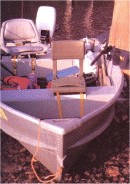 Car Toppers, Part 2 : Equipment and accessories
Car Toppers, Part 2 : Equipment and accessoriesby Chris Tan Last month we looked at the different car-toppers. In this issue we will look at the necessary equipment and other accessories for the boat. It pays to have the necessary equipment on board as fool hardy boat owners would find out that two hours from civilisation is not the time to discover the lack of necessary equipment. Novices should learn from experienced boat owners by observing what other boaters carry on board. This practice can make your fishing trips safer. If you use an outboard engine, make sure the usual essentials are on board like sufficient petrol, two-stroke oil (unless you are a proud owner of a new four stroke outboard engine!), a tool kit, spare spark plugs, cotter pins, sufficient spare propeller shear pins and whatever else needed to keep the outboard engine running. Some boaters even carry a spare propeller! Always carry rope! I carry several short lengths of about three to six meters for tethering the boat and other useful jobs. To have a long length of rope is essential. You never know what it may be used for. It can also double as the anchor rope. 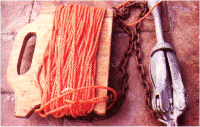 It is prudent to carry an anchor on board, unless you are in a small pond or lake with no intention to remain static offshore. Just a brick may suffice in waters with no current or slow current flow. But anywhere else you would need a proper anchor, capable of holding the bottom. For sand or mud beds the danforth anchor is one of the best. Grapnel anchors work well for rocky or coral beds. I find the small folding grapnel anchors very suitable for small boats, as it folds and packs away very neatly.
It is prudent to carry an anchor on board, unless you are in a small pond or lake with no intention to remain static offshore. Just a brick may suffice in waters with no current or slow current flow. But anywhere else you would need a proper anchor, capable of holding the bottom. For sand or mud beds the danforth anchor is one of the best. Grapnel anchors work well for rocky or coral beds. I find the small folding grapnel anchors very suitable for small boats, as it folds and packs away very neatly.
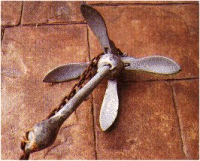 Not long ago, in Pulau Sembilan, we picked up a speed boat at four o'clock in the morning. He had an engine failure and was helplessly drifting with the current. Fortunately for him we were near enough to hear his calls for help. If not, he would have been in dire straits by daylight. This chap did not carry an anchor! If he had one, he would just have had to throw down the anchor and wait for daylight and someone to rescue him. He did not have any rope longer than twenty feet and therefore could not even fashion a makeshift anchor. In short, this very badly equipped boater was a danger to himself and his passengers!
Not long ago, in Pulau Sembilan, we picked up a speed boat at four o'clock in the morning. He had an engine failure and was helplessly drifting with the current. Fortunately for him we were near enough to hear his calls for help. If not, he would have been in dire straits by daylight. This chap did not carry an anchor! If he had one, he would just have had to throw down the anchor and wait for daylight and someone to rescue him. He did not have any rope longer than twenty feet and therefore could not even fashion a makeshift anchor. In short, this very badly equipped boater was a danger to himself and his passengers!
The anchor rope should be at least three times the length of the depth of the anchorage. If not, it may not hold, due to the angle of pull being almost vertical. The anchor has to lie horizontally to the bottom for it to grip. Using a short length of chain between anchor and rope helps to weigh down the upper end of the anchor. In addition, it is resistant to the abrasion that the first few meters of anchor rope would be subjected to from coral and rocks. How about oars? Don't leave home without them! Even when the outboard engine is fully functional, they can be used for manoeuvring the boat in enclosed or shallow waters, or just to move silently, so as to not spook the fish! Invest in proper, solid and well constructed oars. Toy oars are not suitable for paddling miles when the engine is dead. This year two anglers perished in Kenyir dam when their boat was swamped. Life jackets are jackets designed to keep the wearer afloat. Invest in good quality life jackets. What is a few ringgit compared to a life! You can never tell when your life may depend on it. It is a good idea to actually test your life jacket first. Some of the cheap ones on the market may not keep a heavy person afloat! Wear your life jacket, especially when the boat is moving. A life jacket in the boat is of no use if the occupants have been thrown out of the boat after hitting a submerged object at high speeds. A bailing bucket is necessary to remove water from within the boat. I have used all sorts of items for bailing, but small plastic ice-cream containers are especially good. A rag is useful for soaking up the little puddles of water too shallow for a bailing bucket. Rags are also handy to grasp slippery and slimy fish. A little boat can be out fitted with all sorts of useful accessories. In fact these accessories can cost as much as a boat and outboard engine! The problem with car toppers and accessories is that accessories have to be removed when the boat is being transported, unlike trailered boats. 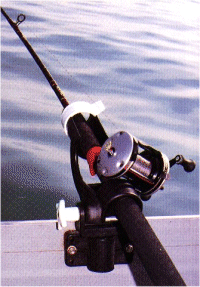 Rod holders are very useful to have in the boat. Nasty things can happen to rods and reels when the boat is bouncing around in the sea. Human limbs can break two hundred ringgit rods like twigs when stumbling around the boat. But leaving the rods protruding out of the rod holders can be just as disastrous when navigating near trees and other such objects.
Rod holders are very useful to have in the boat. Nasty things can happen to rods and reels when the boat is bouncing around in the sea. Human limbs can break two hundred ringgit rods like twigs when stumbling around the boat. But leaving the rods protruding out of the rod holders can be just as disastrous when navigating near trees and other such objects.
The simplest and most economical rod holder is a short length of PVC pipe bolted on to the boat. At the other end of the financial scale are rod holders that lock in any horizontal or vertical position. These versatile rod holders can also be removed from their mountings with a quick twist. Trolling with these rod holders is a breeze. The good quality models are very tough and easy to use. Making the seat more comfortable is a simple matter. Pieces of foam make a huge difference to a whole day's fishing. The padding makes the seat softer and cooler. The hot sun can make the fibreglass or metal seat extremely hot! Again on the other end of the financial scale, swivel seats are available. Special clamps can be purchased to make the seat easy to remove from a car topper's bench seat. However rigging up a home- made clamping system is viable. These swivel seats make fishing in a car topper very comfortable and relaxing. Back aches and sore derrieres are a thing of the past with these fabulous swivel seats! 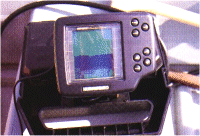 Nowadays portable fish finders are readily available. They come with their own battery pack built into the carrying case. Most models use two six volt lantern batteries. The LCD display is also mounted on the case. A suction cup is used to secure the transducer on the transom. Everything is packed into the carrying case. These portable models are very basic systems and are invaluable for measuring depth and looking at the terrain of the sea, lake or river bed. Surprisingly these simple portable fish finders are quite accurate in picking up fish shoals and isolated fish of all sizes.
Nowadays portable fish finders are readily available. They come with their own battery pack built into the carrying case. Most models use two six volt lantern batteries. The LCD display is also mounted on the case. A suction cup is used to secure the transducer on the transom. Everything is packed into the carrying case. These portable models are very basic systems and are invaluable for measuring depth and looking at the terrain of the sea, lake or river bed. Surprisingly these simple portable fish finders are quite accurate in picking up fish shoals and isolated fish of all sizes.
An alternative source to paddle power is electricity. Electric trolling motors are invaluable for moving silently in still fresh waters. There are also some salt water models with power equivalent to a three horse power outboard engine. Sure, paddle power is cheaper but an electric trolling motor is quicker and generally easier to control with one hand especially when that big fish connected to the line is swimming around a tree trunk! No messing around fumbling for the oar, just a quick twist with one hand to move forward, backwards or in a circle! The disadvantage of using an electric motor is having to lug around a heavy lead acid battery with enough capacity to last several days of lure casting in a dam. Ideally, deep- cycle lead acid batteries should be used. They have a longer life than the average vehicle lead acid battery. The normal lead acid battery is designed to discharge high power for short periods (like starting a car). Deep-cycle batteries can discharge electricity continuously till almost drained, then recharged. Normal batteries have a very short life span when used in this manner. Unfortunately deep-cycle batteries are expensive when they are available. To protect the floor of the boat from unnecessary wear from heavy objects like the fuel tank or lead acid batteries, cheap rubber car mats are very practical. Other pieces of equipment for fishing like gaffs and landing nets should be carried, as larger fish can not be dragged into the boat as can be done on a beach or sloping bank. I find it more convenient to use a folding net for the smaller fish, as opposed to the rigid models that take up space in the boat. However I found that these folding nets are not very strong when I tried to lift a 4 kg toman into the boat. Nevertheless with careful handling, it still can lift a heavy fish. By placing the handle in a vertical position it is possible to lift the fish up, because when it is in a horizontal position, the section where the landing net folds, is unable to take the load. Gaffs are essential for the larger fish, especially the toothy ones, as their teeth would tangle and tear a landing net. Use a really solid roof rack. Do not skimp here. The cheap ones bend, come loose and cause all sorts of nasty incidents you would not want to happen on the highway. What is the cost? Pretty close to two hundred ringgit. By the way, just in case you did not know, the Road Transport Department requires a permit (it is free) to carry a boat on the roof rack of a vehicle. Adhesives such as epoxy resins for temporary repairs on extended trips are invaluable. For aluminium alloy boats there are special epoxies for use on metal surfaces. Recently I came across special epoxies like plasticine that can be used underwater! For inflatables there are special repair kits. The air pump should be carried on board at all times in case the inflatable needs to be topped up. Other pieces of equipment that can be carried aboard varies from hi-tech equipment like hand-phones to call for help, or to let the wife know we would be late, or hand held GPS units for navigation in large dams, or to something as simple as a torch! As you can see, the amount of paraphernalia that can be carried in a boat as small as a car-topper can be tremendous, so use sound judgment as to what is essential. |